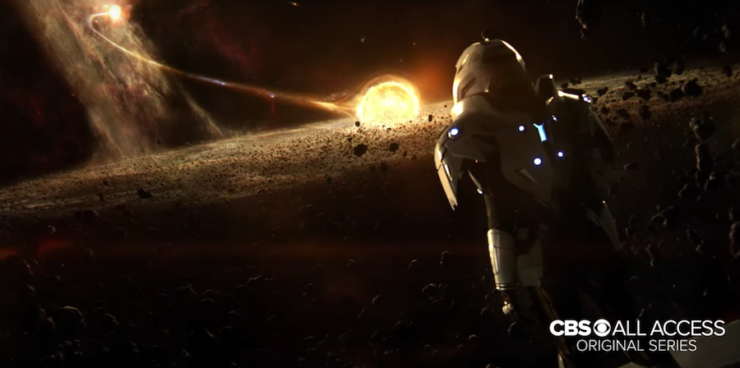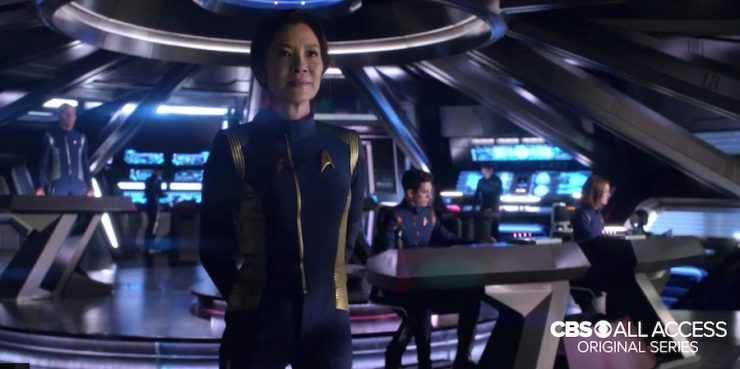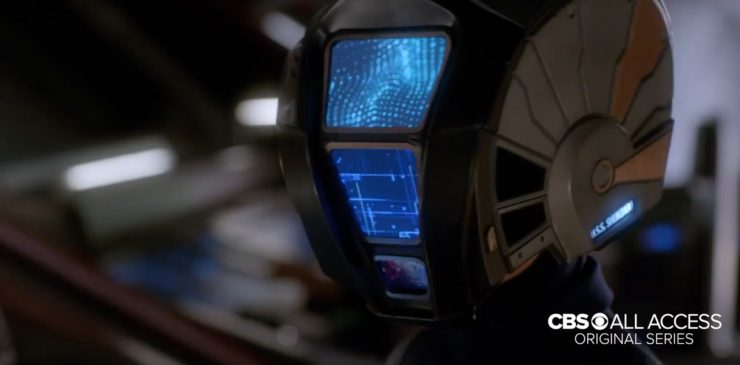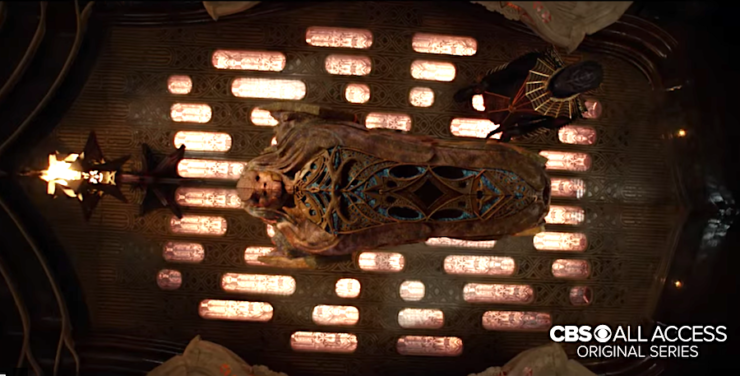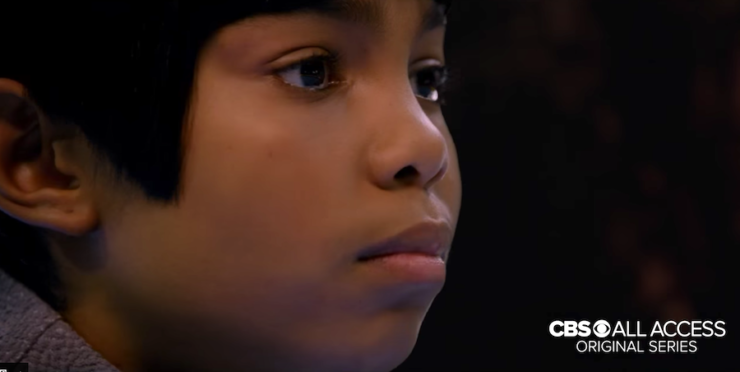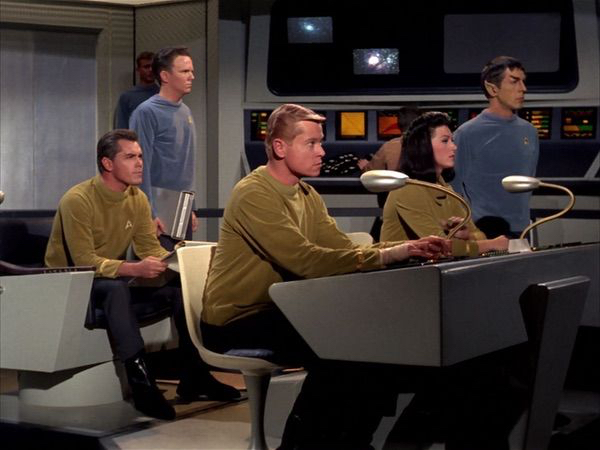Oddly, we don’t actually see the U.S.S. Discovery in the first Star Trek: Discovery trailer!
The absence of the titular ship is just one of many interesting aspects hiding in the first trailer for Star Trek: Discovery, the new Star Trek show coming to CBS this fall. Although light on plot information, there are nevertheless several key visuals that promise a deep exploration of Trek lore for longtime fans of the franchise.
Let’s take a look!
First, some basic facts: This series takes place in the year 2255, “ten years before Kirk, Spock, and the Enterprise”. (The first season of the original series spans the years 2265 and 2266.) Tensions between the Federation and the Klingon Empire are high, and in a decade or so the Romulans will furtively enter the scene. Starfleet has been in existence for not-quite-a-century at this point and has just introduced a new series of top-of-the-line Constitution-class ships, of which the Enterprise is one.
But this isn’t about the Enterprise.
1.) The only Federation ship we see in the trailer is the U.S.S. Shenzhou.
The Shenzhou is captained by Captain Philippa Georgiou (Michelle Yeoh), who we first see on a sandy planet with her “number one”, Commander Michael Burnham (Sonequa Martin-Green). We know that for the majority of the series we will be following the voyages of Burnham as a commander on the Discovery, but for the purposes of this trailer (and the pilot episode, most likely) we’re seeing the series of events that takes Burnham from the Shenzhou to the Discovery.
There are three tells that confirm we’re seeing the Shenzhou and not the Discovery. The first is immediate and obvious: Georgiou hails her ship for beam out and she’s been previously mentioned as captain of the Shenzhou, not the Discovery. (The Discovery‘s captain is named Lorca and is played by Jason “Lucius Malfoy” Isaacs, who we did not see in this trailer.) We also get a glimpse of the ship’s registry number during the brief snippet of the ship going to warp and it’s different than the one we’ve seen for the Discovery. Finally, this cute little robot on the bridge is clearly displaying the ship’s name:
Fun fact: Shenzhou is the moniker for the China’s current manned space program (roughly equivalent to the U.S.’s Apollo space program) and, if you’re being dreamy and hopeful, means “Divine Craft”. (If you’re not, you can also translate it as just “Magic Boat.”) Considering Saru’s (played by Doug Jones) awkward FYI about death coming later in the trailer, it doesn’t seem like we’re going to get a lot of time to get to know the rest of the crew of the U.S.S. Magic Boat.
So. What, or who, is going to shatter the Shenzhou to the stars?
2.) That sarcophagus could contain the Klingon Empire’s greatest monster.
The Shenzhou finds an “object of unknown origin” in a debris field and encounters the Klingons as a result. A lot of Klingons, actually. (The trailer shows at least three warbirds warping in, with five more following.) A fight clearly ensues on multiple fronts, between the Shenzhou and the Klingons, and between Michael Burnham and the other space-walking Klingon (who has the most awesome space suit in the history of ever).
Later, we see our main Klingon antagonist T’Kuvma (Chris Obi) leading what might be a Klingon death ritual. The presence of the sarcophagus makes the death ritual a little uncertain, as it is based around the concept that the spirit is of importance and the body is disposable. Klingons probably wouldn’t go to the trouble of obtaining and preserving the body of a great warrior after they had perished, nor would they create a vessel for the spirit, since both would be anathema to their funeral rites.
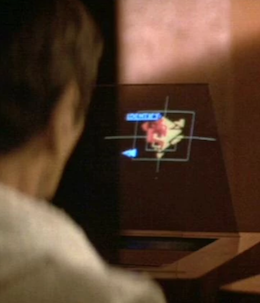 The Klingon death ritual wasn’t always like this, however. Star Trek IV: The Voyage Home gives us the smallest of hints that Klingons, like the Egyptians, actually used to mummify the remains of great leaders! (The hint comes in one of the opening scenes. As Spock is taking a test to hone his intellect, he briefly identifies a symbol as a “Klingon mummification glyph”. It’s never brought up again.)
The Klingon death ritual wasn’t always like this, however. Star Trek IV: The Voyage Home gives us the smallest of hints that Klingons, like the Egyptians, actually used to mummify the remains of great leaders! (The hint comes in one of the opening scenes. As Spock is taking a test to hone his intellect, he briefly identifies a symbol as a “Klingon mummification glyph”. It’s never brought up again.)
The press materials for Star Trek: Discovery describe T’Kuvma as a man attempting to unite the great Houses of the Klingon Empire, and there are rumors that T’Kuvma represents “ancient” Klingons. Indeed, Sarek seems to be warning Michael of T’Kuvma’s potential in the trailer when he says, “Great unifiers are few and far between, but they do come. Often such leaders will need a profound cause [emphasis mine] for their followers to rally around.”
A “profound cause” suggests T’Kuvma is seeking an ideological, perhaps religious, icon or tract with which to rally the Klingon people. There are two figures in Klingon lore who are ancient enough to have been mummified, who would be worth sending an entire fleet (eight ships!) to locate, and who would be instantly recognizable to Klingons on a societal and/or spiritual level.
The first is Kahless the Unforgettable, who was the originator of the Klingon Empire and its entire societal and moral system. Klingons hold the concept honor (especially through combat) above all, and Kahless is the individual who instituted the foundation of that system. Trek fans know he was real, and that he instituted change and unification in the Klingon peoples, but the Klingon mythos goes much farther, proclaiming that Kahless departed this mortal plane in order to conquer the afterlife itself, and that he claimed he would one day return from that voyage into the netherrealm.
Finding Kahless would certainly give T’Kuvma a strong chance at uniting the Klingon people, but this theory doesn’t seem quite right. For one, that story has essentially been told through Star Trek: The Next Generation and Star Trek: Deep Space Nine. Second, why would finding Kahless be a story, or even a worry, from the perspective of the Federation, the perspective that we’re ostensibly seeing in Star Trek: Discovery? A united Klingon Empire poses a military threat to the Federation, but the Federation attempting to capture or destroying the Klingon equivalent of Jesus in order to avoid that doesn’t sound at all like how the Federation operates.
The presence of Sarek further complicates the theory that Kahless is in the sarcophagus, as according to the history of this Trek timeline (known as the Prime Timeline) Sarek has just started working on what will be known as the Treaty of Alliance between the Federation and the Klingon Empire. (This takes decades and we don’t see success until Star Trek VI: The Undiscovered Country.) Perhaps Sarek wants the Federation to obtain Kahless as a bargaining chip? A gesture of good will? If so, why would Sarek sound worried (as worried as a Vulcan can sound, anyway) when describing T’Kuvma as a uniter? And why would he sound worried about the sarcophagus being found in the first place?
It seems more likely that Sarek sees T’Kuvma as the leader of an unstable radical element that will make any treaty impossible. If that is true, then Kahless may not be the ideological icon that T’Kuvma admires. Rather, T’Kuvma may have found the sarcophagus of Molor, the chaotic, genocidal tyrant that Kahless killed. T’Kuvma may, in fact, find Kahless’ system of honor weak, feeling that the Klingon people have become soft and unguided as a result. Finding Molor’s iconography would solidify the seriousness and legitimacy of T’Kuvma’s call for unity through “strength”. (Note: At this point in history, the Klingon people are split into two racial strains. One which are descendants of “Augments” that look and act more like humans, and the other that are “natural born” Klingons. T’Kuvma’s calls for unity may very well have a racial and puritanical component to them. After all, we don’t see any Augments in the trailer.) Perhaps T’Kuvma offers a radical “true way,” one that will bring Klingons back into prominence in the galaxy. There are a variety of ways this plot arc would allow Star Trek: Discovery to comment on the present day and display the better angels within ourselves, and isn’t that what we really seek from a Star Trek TV show?
Another fun fact: This sarcophagus is found in a solar system that is about to go supernova! There are two ways supernova happen: either a singular supermassive star collapses or a binary star system cannibalizes itself and the resulting star becomes too supermassive to sustain its structure. This process is clearly occurring in the system in which we see Michael spacewalking, and it’s well on its way to conclusion. Odds are that asteroid disc we see in the trailer used to be a planet. What may have been buried on that planet? Perhaps a ruler so incredibly despised that the Klingons wanted to ensure he and his legacy were unfindable and/or killed by The Most Fire Galactically Possible? (Although if this is Kahless is in the sarcophagus then you can see why they’d want to hurry and get it out of that system!)
3.) Michael is Basically a Redo of Spock (for Sarek)
Great unifiers are few and far between, but they do come. Often such leaders will need a profound cause or their followers to rally around.
This doesn’t just apply to T’Kuvma, but Michael herself. The design of the U.S.S. Discovery suggests that it may be a combination of Federation and Klingon ships, and if Michael is the one who finds (and perhaps obtains) the sarcophagus then she’ll be placed squarely in the middle of cultural and military struggle between factions of the Klingon Empire and the Federation. She can either be passive, or attempt unification between these warring factions.
Most likely it will be the latter (there’s no story otherwise!), but the trailer suggests this will be more out of a sense of duty to the Federation and to Sarek. We get a brief glimpse of Sarek lamenting that the young Michael’s “too human” tongue cannot speak the Vulcan language, which suggests that Sarek adopted Michael at some point after Spock left for Starfleet Academy. (Michael doesn’t have the Vulcan ears or physiology to suggest that she’s biologically half-Vulcan, but she’s clearly being raised on Vulcan.) Why would Sarek adopt a human child? He may have found himself with her as the result of a crisis, and perhaps saw an opportunity to mold Michael in a way that he could not do with Spock.
This would create fascinating tension in the series. Is Michael doing what she wants out of a sense of duty? Or resentment? What are Michael’s personal wishes and what are the wishes instilled by a childhood spent under Sarek’s tutelage?
4.) Would Michael Ever Get to Discuss Her Origins With Spock?
Possibly. Sarek is clearly communicating long distance and there may come a Very Special Episode where Michael needs guidance from the only other person who has gone through what she’s gone through. (And Zachary Quinto started out in television, remember!)
There’s also a good chance that the events on Star Trek: Discovery will affect the current voyages of the U.S.S. Enterprise, which is commanded by Christopher Pike at this point in the history of Trek, and which criss-crosses Federation space, going from Vega, to Talos, to Rigel…which is very close to the Klingon border.
Star Trek: Discovery certainly seems as if it’s setting up a nicely complex story. There are elements in the trailer that suggest a quest of sorts, as well, after the initial events of the opening episode, although there’s not enough info in the trailer to conjecture as to what that quest might be focused on. Here’s hoping we get to see more from the show on this year’s San Diego Comic Con!










